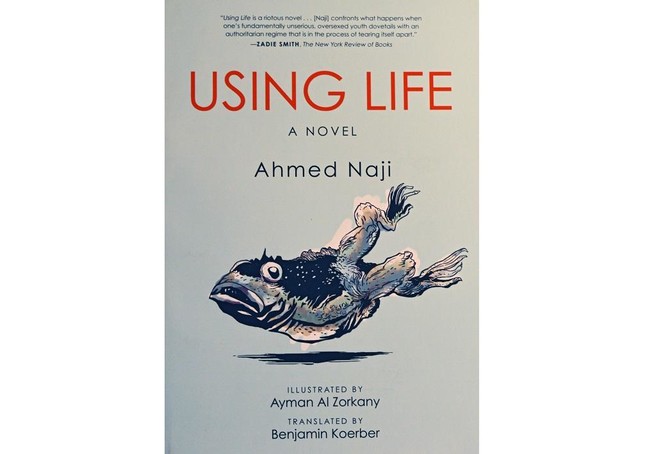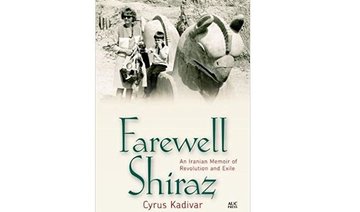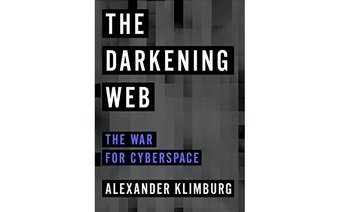“Using Life” by Ahmed Naji was first published in Arabic in 2014 and received praise throughout the Arab world. In 2016, however, Naji would be sentenced to two years in prison after a reader complained that the book “harmed public morality.” Naji’s arrest was not only a shock to him, but to the country. It was the first time in modern-day Egypt that a literary writer was imprisoned on such a charge. It took rallies and support from around the world to get Naji released at the end of 2016 and to have his conviction overturned the following year. The author of several non-fiction works, Naji is an editor and contributor at one of Egypt’s leading literary magazines, Akhbar Al-Adab, and continues to await retrial in Cairo. In the meantime, he was awarded the PEN/Barbey Freedom to Write Award for his struggles in 2016.
In 2016, Benjamin Koerber, an assistant professor at Rutgers University, translated “Using Life” from Arabic into English, introducing it to a new audience.
This is not only a unique book, it is strangely fascinating and terrifying. Naji begins the story with a storm in July, a “Tsunami of the Desert” that buries Cairo under a layer of sand. For days and nights, Cairo is blanketed by the storm; visibility is low, air conditioners are malfunctioning, traffic accidents are increasing and the heat and sand have paralyzed the city’s infrastructure. The electricity is out, communication is down and the government acts as if nothing is wrong. It is a disaster that “stretched from Nasr City in the east to the Pyramids of Giza in the west, and from Maadi in the south to the edges of Shubra in the north.” And then the earthquakes begin.
Naji’s narrative is bleak and dark, even when not meant to be. From the beginning of the book Naji introduces to the reader the idea that Cairo will be destroyed. What follows is entire neighborhoods being reduced to rubble or being swallowed whole by sink holes. The most prominent historical sites of the city are no more. “The real tragedy, however, was the millions who lost their lives, and even more, the additional millions who survived to bear the pain of loss.”
And then we meet documentary filmmaker, Bassam Baghat. He is a tainted, introspective and contemplative individual who struggles with his own happiness as he attempts to figure out where he belongs in life and in Cairo. Switching between the past, present and future, it is through Baghat that the reader sees the bleak outlook he has for Cairo. He thinks of people as a “pitiful bunch, wandering the desert under a thorny sun, imagining ourselves to be chasing after things that are actually chasing after us.”
In-between Naji’s narrative are Ayman Al-Zorkany’s illustrations that have been exhibited in Cairo and Alexandria. In the book, Al-Zorkany’s work is dark, shadowy and colorless. Each illustration has a post-apocalyptic feel to it, accompanied with a feeling of helplessness and hopelessness. His work is showcased uniquely as he is allowed the space to unfold the events of the story in his own way. His characters and scenes are detailed, but there is so much left undrawn. It is as if you see the characters, but their personalities and intentions continue to be mysterious and nefarious to the reader. The curved lines and particular eccentricities of his drawings create constant motion in the characters, which gives the reader an uneasy feeling. The illustrations, together with the dialogue, create a palpable feeling of impending doom.
Naji’s story is raw and deep. His main character is cognizant of life and how opportunity shapes life. His pessimism overwhelms his attitude and his relationships within the story. There is an added layer of suspicion and conspiracy as Naji moves on to the Society of Urbanists, a secret group that Baghat begins to work for. Baghat is to create a number of documentary films about Cairo’s architecture and its urban planning, which turns out to not be as harmless as it sounds.
The Society of Urbanists finds that Cairo has been a terrible burden on its residents. Instead of the city shaping its residents, the opposite is taking place, causing its architecture to be of little significance and more consequence. But Cairo is only one city and the Society of Urbanists have plans for cities around the globe.
With global conspiracies looming, Baghat’s observations and introspections are more meaningful. People and nature are changing the world, whether consciously or not, and the residents of Baghat’s Cairo are adapting to life as best they can. That is what they have always done. The sweltering heat does not stop the city from functioning, or stop the women in abayas from venturing outside. The billboards along the highway, the traffic, nor the stench of waste in certain areas can stop life. Baghat observes “entire neighborhoods living off electricity stolen from the lampposts along the highway” and even the disaster, the “Tsunami of the Desert,” cannot stop people from living in the city.
There is a desperation in the narrator, a nostalgia for a Cairo that has been lost for decades. It is a city that makes people miserable, as Naji writes, “for all that Cairo takes from its residents, it gives nothing in return — except, perhaps, a number of lifelong friendships that are determined more by fate than any real choice.” Naji’s characters are very specific, each inhabiting their own space in their own way. In a city of millions, no two people can be the same, as in Naji’s book.
The book is dark and questions life in a city and the function of both the city and its people. The message conveyed longs for purpose and questions what human beings think of as purposeful. It is intellectually challenging and mixed with romantic verses by Egyptian poets and lyricists, allowing the flourishing notion that futuristic urban planning can work with the historical architecture that makes Cairo the unique city that it is.
Book Review: A controversial story on storm-hit Cairo
Book Review: A controversial story on storm-hit Cairo

What We Are Reading Today: ‘Chinese Espresso’ by Grazia Ting Deng

Italians regard espresso as a quintessentially Italian cultural product—so much so that Italy has applied to add Italian espresso to UNESCO’s official list of intangible heritages of humanity. In this book, Grazia Ting Deng explores the paradox of “Chinese Espresso”— the fact that this most distinctive Italian social and cultural tradition is being preserved by Chinese immigrants and their racially diverse clientele.
What We Are Reading Today: ‘Bartleby and Me’

Writers love to write about writing and none seemingly more so than Gay Talese, the journalist known as a pioneer of the American literary moment called “New Journalism.” This style of writing originated in the 1960s and ‘70s and combines journalistic research with creative non-fiction.
Talese started his career as an obituary writer at the New York Times and, later, as a magazine writer who ended up reluctantly penning the most widely read magazine articles of all time. He showcases some of that editorial wisdom — and reporting mishaps — in his 2023 book, “Bartley and Me: Reflections of an Old Scrivener.”
Now 92 years old, he writes vividly about his early reporting days and the stories behind the stories; he masterfully weaves in stray strands that somehow come together into a coherent narrative. Talese writes crisp copy. He writes about nobodies and somebodies with equal fervor.
He recalls his time as a young reporter on assignment where, at the insistence of his persistent editor, he attempted to sit down for an interview with the elusive and super-famous star Frank Sinatra. Talese recounts how he repeatedly tried — and failed — to pin down “Ol’ Blue Eyes” while chasing him around California in the 1960s. He eventually published his distinctively titled profile, “Frank Sinatra Has a Cold,” in the April 1966 issue of Esquire. That piece of writing is considered one of the most celebrated pieces of magazine journalism to date.
Talese’s tales are mostly centered around his time in New York. He recalls things in meticulous detail — for example, pointing out the exact address and precise building within a neighborhood to help the reader visualize the space. The city is always a leading part of the story.
“New York is a city of things unnoticed,” he wrote 60 years ago, something that could easily be written today. He recalls the early days of his journalistic career in New York, churning out newspaper copy and still, now, being ever-so-curious about everything. The pages of this book show that we all, alongside him, still have much more to notice.
The title of the book was inspired by American author Herman Melville’s short story, “Bartleby, the Scrivener: A Story of Wall Street,” published in the 1800s. This is a social criticism piece about a lawyer who hires a peculiar scrivener or clerk, Bartleby, and the adventures (or misadventures) that ensue.
In his version, Talese shares with us a fresh piece of original reporting titled “Dr. Bartha’s Brownstone,” which is his version of “Bartleby.” This time, however, Bartleby is an unknown doctor who makes his bombastic mark on the city one random summer day. It is a brilliant piece of journalism about journalism.
What We Are Reading Today: ‘The Proof Stage’ by Stephen Abbott

The discovery of alternate geometries, paradoxes of the infinite, incompleteness, and chaos theory revealed that, despite its reputation for certainty, mathematical truth is not immutable, perfect, or even perfectible.
Beginning in the last century, a handful of adventurous playwrights took inspiration from the fractures of modern mathematics to expand their own artistic boundaries.
What We Are Reading Today: ‘The Royal Inca Tunic’ by Andrew James Hamilton

The most celebrated Andean artwork in the world is a 500-year-old Inca tunic made famous through theories about the meanings of its intricate designs, including attempts to read them as a long-lost writing system.
But very little is really known about it. “The Royal Inca Tunic” reconstructs the history of this enigmatic object, presenting significant new findings about its manufacture and symbolism in Inca visual culture.
What We Are Reading Today: ‘The Evolution of Power’ by Geerat Vermeij

Power has many dimensions, from individual attributes such as strength and speed to the collective advantages of groups.
“The Evolution of Power” takes readers on a breathtaking journey across history and the natural world, revealing how the concept of power unifies a vast range of phenomena in the evolution of life—and how natural selection has placed humanity and the planet itself on a trajectory of ever-increasing power.

















